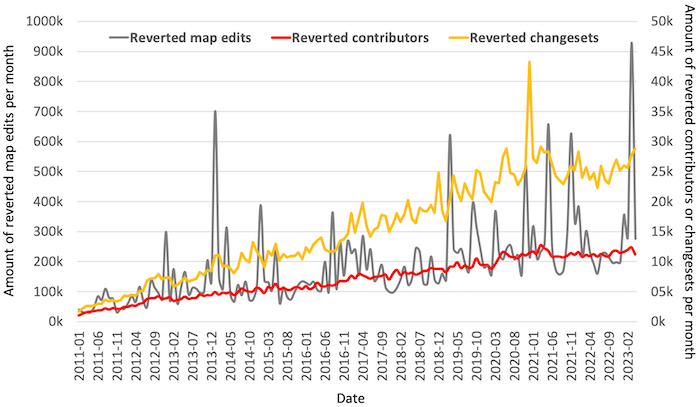Wait, someone did what?
Exploring Reverted Map Edits in OpenStreetMap
by Pascal Neis - Published: June 1st, 2023
The OpenStreetMap (OSM) project has over 10 million registered members, with around 2 million user profiles having made at least one map contribution. However, a closer look reveals that there has been a slight decline in the number of active contributors over the last three years. Despite the extensive global mapping community, there are instances where individuals or automated bots disregard the consensus norms of the community when editing data. These situations arise due to disagreements regarding the appropriateness of certain tagging or features within the OSM database. To address these issues, a change rollback process, commonly referred to as reverting, is used to combat vandalism and correct ‘mistakes’ by restoring a previous version of the data.
Two years ago, I added additional statistics to the “How did you contribute to OSM?” page for quality assurance purposes. The numbers for each contributor profile were derived from an analysis of the full history OSM planet dump and changeset tags, including the specific editor used. While this pragmatic approach provides valuable insights, it’s important to acknowledge that the obtained numbers are estimations rather than exact figures. Furthermore, I received several inquiries regarding the implementation of the processing involved in identifying the displayed “reverted changes”.
Over the past few weeks, I have developed an advanced processing pipeline. This involved revisiting the comprehensive OSM planet dump and examining the evolution of each entity (node, way, relation) in relation to its previous states. Specifically, an entity with a higher version number was identified as a revert if it had the same latitude/longitude coordinates (for nodes), tags (key-value pairs), and/or members (for relations) as a previous version. In simpler terms, if a mapper changed “X” to “Y” and another mapper subsequently altered it back to “X”, it would be counted as a revert.
The following graph illustrates the amount of reverted map edits, changesets, and the contributors affected per month. This visualisation offers some initial insights into the scope and impact of reverted changes. It’s important to note, that the these numbers don’t include any actions related to reverted data imports.

It is also necessary to look more closely at the specific entities that are counted as “reverted”. Are they primarily nodes with a few tags, or are they ways and relations with extensive mapping histories in active areas? These specific aspects, among others, will be explored in an upcoming blog post or possibly published as part of a scientific research study.
What are your thoughts? I think many of you might be curious to discover whether your own map entities have been reverted. Please feel free to leave a comment on my OSM diary page, where I have cross-posted this article.